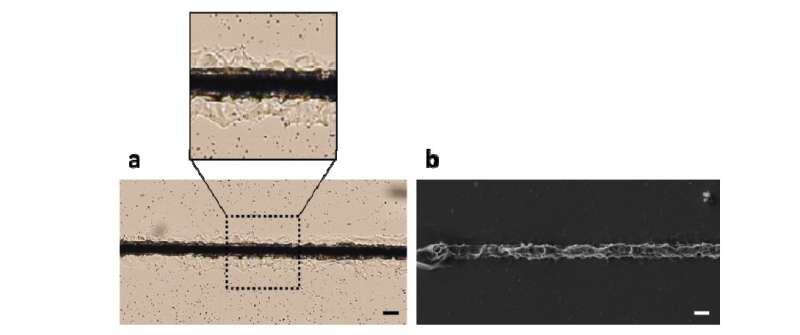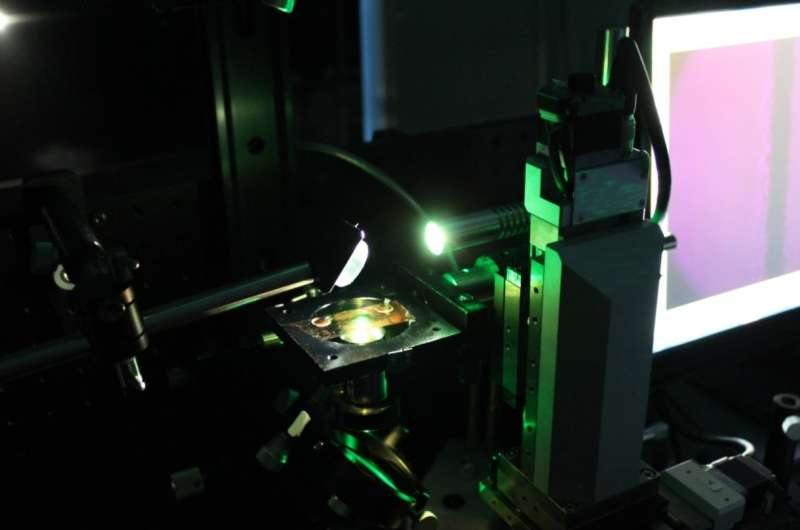Metal-silicone microstructures could enable new flexible optical and electrical devices

For the first time, researchers have used a single-step, laser-based method to produce small, precise hybrid microstructures of silver and flexible silicone. This innovative laser processing technology could one day enable smart factories that use one production line to mass-produce customized devices combining soft materials such as engineered tissue with hard materials that add functions such as glucose sensing.
The metal component of the microstructures renders them electrically conductive while the elastic silicone contributes flexibility. This unique combination of properties makes the structures sensitive to mechanical force and could be useful for making new types of optical and electrical devices.
"These types of microstructures could possibly be used to measure very small movements or changes, such as a slight movement from an insect's body or the subtle expression produced by a human facial muscle," said research team leader Mitsuhiro Terakawa from Keio University, Japan. "This information could be used to create perfect computer-generated versions of these movements."
As detailed in the journal Optical Materials Express, from The Optical Society (OSA), the researchers produced wire-like structures of silver surrounded by a type of silicone known as polydimethylsiloxane (PDMS). The researchers used PDMS because it is flexible and biocompatible, meaning that it is safer to use on or in the body.
They fabricated the structures, which measure as little as 25 microns wide, by irradiating a mixture of PDMS and silver ions with extremely short laser pulses that last just femtoseconds. In one femtosecond, light travels only 300 nanometers, which is just slightly larger than the smallest bacteria.
"We believe we are the first group to use femtosecond laser pulses to create a hybrid material containing PDMS, which is very useful because of its elasticity," said Terakawa. "The work represents a step towards using a single, precision laser processing technology to fabricate biocompatible devices that combine hard and soft materials."

Turning two laser processes into one
The one-step fabrication method used to make the hybrid microstructures combines the light-based chemical reactions known as photopolymerization and photoreduction, both of which were induced using femtosecond laser pulses. Photopolymerization uses light to harden a polymer, and photoreduction uses light to form microstructures and nanostructures from metal ions.
The fabrication technique resulted from a collaboration between Terakawa's research group, which been studying two-photon photoreduction using soft materials, and a group at the German research organization Laser Zentrum Hannover, that has been advancing single-photon photopolymerization of PDMS.
To create the wire microstructures, the researchers irradiated the PDMS-silver mixture with light from femtosecond laser emitting at 522-nm, a wavelength that interacts efficiently with the material mixture. They also carefully selected silver ions that would combine well with PDMS.
The researchers found that just one laser scan formed wires that exhibit both the electrical conductivity of metal and the elasticity of a polymer. Additional scans could be used to produce thicker and more uniform structures. They also showed that the wire structures responded to mechanical force by blowing air over the structures to create a pressure of 3 kilopascal.
The researchers say that, in addition to making wires structures, the approach could be used to make tiny 3D metal-silicone structures. As a next step, they plan to study whether the fabricated wires maintain their structure and properties over time.
"Our work demonstrates that simultaneously inducing photoreduction and photopolymerization is a promising method for fabricating elastic and electrically conductive microstructures," said Terakawa. "This is one step toward our long-term goal of developing a smart factory for fabricating many human-compatible devices in one production line, whether the materials are soft or hard."
More information: Yasutaka Nakajima et al, Femtosecond-laser-based fabrication of metal/PDMS composite microstructures for mechanical force sensing, Optical Materials Express (2017). DOI: 10.1364/OME.7.004203
Journal information: Optical Materials Express
Provided by Optical Society of America





















